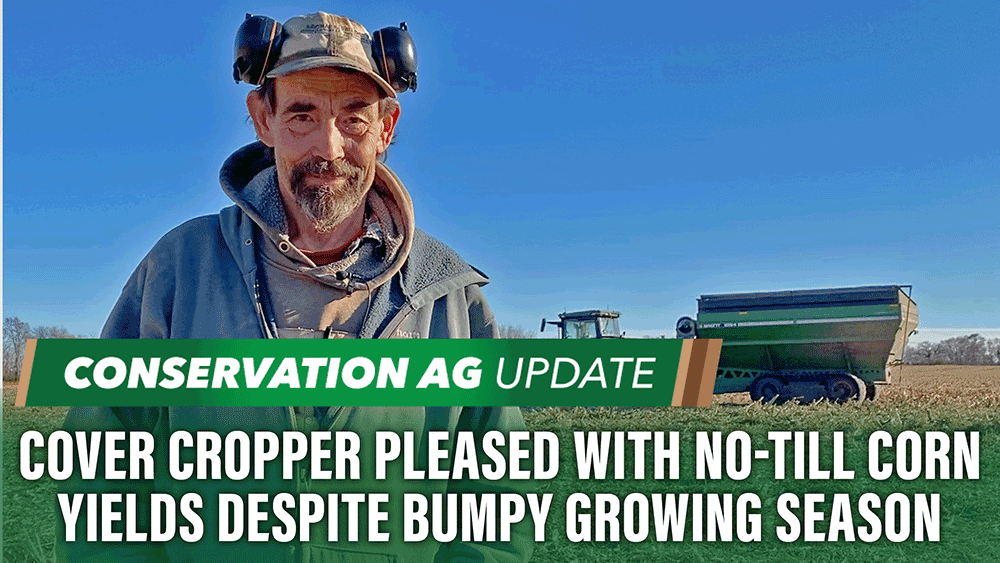On this episode of Conservation Ag Update, brought to you by CultivAce, we talk to East Troy, Wis., no-tiller Jim Stute as he wraps up corn harvest. Stute reflects on a challenging year and shares how he was able to conserve moisture with cereal rye.
Plus, James Crouch, National Segment Manager for Yokohama Off-Highway Tires, says now is the perfect time to check your ag tires. The self-proclaimed “tire nerd” explains what to look for when doing an inspection, and why it’s important to make sure your tires aren’t overinflated.
In the Cover Crop Connection, assistant editor Mackane Vogel takes us inside a field day at the University of Wisconsin, where weed scientist Rodrigo Werle examines how much cereal rye biomass is needed for optimal weed suppression.
In the Farmer Feature segment, New Prague, Minn., grower Greg Entinger shares how he slashed his fertilizer costs by 50% after switching from conventional tillage to strip-till. Also in the episode, Canadian-based ag tech startup Lucent BioSciences unveils a new micronutrient fertilizer for corn and soybeans, and a South African no-tiller grows a tillage radish that’s almost as big as him!
This episode of Conservation Ag Update is brought to you by CultivAce.
CultivAce is a West Coast manufacturer and distributor of a comprehensive line of foliar and starter fertilizers. CultivAce offers innovative solutions that drive agricultural crop yields and cultivate profitableoutcomes.
With a relentless focus on delivering the highest quality foliar and starter fertilizers, we are committed to empowering growers with the tools they need to achieve remarkable results. CultivAce is built on two fundamental principles: products must be the highest quality, and they must make the grower money. If a product doesn’t meet these standards, CultivAce doesn’t manufacture it.
For more information go to CultivAcegrowth.com.
TRANSCRIPT
Jump to a section or scroll for the full episode...
- No-Till & Cover Crops Pay Off in Challenging Year
- “Over 75% of Tractor Tires Are Overinflated”
- Cover Crop Connection: Controlling Waterhemp with Cereal Rye
- Farmer Feature: Greg Entinger, New Prague, Minn.
- Ahead of the Curve: Soileos Micronutrient Fertilizer
- Photo of the Week: Massive Tillage Radish
No-Till & Cover Crops Pay Off in Challenging Year
Welcome to Conservation Ag Update! I’m Noah Newman. Hope everyone had a great Thanksgiving. December is here and harvest season is in the books. It was a late finish for some of our friends in southeast Wisconsin.
Let’s head to East Troy, Wis., where longtime no-tiller Jim Stute wrapped up corn harvest just a few days before Thanksgiving. Stute will remember the 2023 growing season as a challenging one. It was like a roller coaster — wet in the spring, dry in the summer, some good rainfall late followed by a scorching hot Labor Day weekend. But overall, Stute is happy with how his corn turned out, with yields as high as 230 bushels per acre in some of his fields.
“I attribute that to the no-till, the resiliency of the field, the soil from the no-till and also to cover crops, and very early termination of the cover crop. As soon as I planted, I terminated, and conserved all the moisture that was there. We used the cover crop (cereal rye) to dry out the seed bed and the residue to cut evaporative losses. I’m pleased at how that worked. Soybeans, not so much. Our soybean yields were down from our average. We were probably in the mid-40s. They just did not respond well to the drought. Same thing — we had the cover crop on there. They suffered. One more thing I’d like to say — this is my 4th year using drought guard hybrids. I’m pleased at how they perform when it is so dry.”
“Over 75% of Tractor Tires Are Overinflated”
As things start to slow down a bit, now is the perfect time to check your equipment, especially those tires. Did you know that over 75% of tractor tires are overinflated? That’s according to ag tire expert James Crouch, who says properly inflated tires will help reduce compaction, save fuel and increase yield.
“Get out in your barn, look at your tires. Just look at them. If you have duals, it’s not easy to see the inside of the tire. But get a flashlight, get down there and look at the tire to make sure you don’t have cracks. Make sure you don’t have any leaks. Because especially with duals — I’ll say this as a North American problem more than a European problem — if one of those tires is higher inflated than the other, you’re overloading the other tire. Because a tire with more inflation pressure than the tire next to it is taller.
So, you’re putting stress on another tire that’s not necessarily needed. Make sure your tire pressures are uniform. Make sure you don’t have cracks. Make sure you don’t have any objects lodged in the tire. It’s not uncommon to see bolts, deer antlers, stubble in some cases. Because at the end of the day, if you have time to do it now, do it because you don’t want to do that when you’re prepping your planter in spring and all of a sudden you need a tire, you call your tire guy, and he’s two weeks out.”
Crouch says contact your dealer to get connected with a tire expert. They’ll help you figure out where your tire pressure needs to be.
Cover Crop Connection: Controlling Waterhemp with Cereal Rye
Cereal rye can be used to suppress weeds. At this Brooklyn, Wisconsin, field day, Jose Nunes, a graduate student at weed scientist Rodrigo Werle’s UW-Madison research and extension lab, shared his findings about how much cereal rye biomass is needed for optimal weed suppression.
“When it comes to weed suppression, waterhemp suppression in my case, which is the weed that I’ve been working with, we need biomass. When we increase the biomass we also increase the suppression, so there are fewer waterhemp plants in the plot and the more biomass, the better the weed suppression.”
“But if you notice on that plot, when we go beyond 4500 pounds per acre of dry biomass, that’s when we start to see a good separation in waterhemp density. So, if you ask us today, how much is good enough, I would say 4500 pounds, oftentimes can provide the effect of waterhemp suppression. If you talk about different weed species like gant rag which is a large broadleaf seed weed, you will probably need more.”

|
|
His research also showed the importance of using a cover crop along with an herbicide program for successfully suppressing weeds.
A cereal rye cover crop shouldn’t be a substitute for herbicide applications, Nunes says, because the pre-emergence herbicide is needed for residual weed control.
To learn more about Nunes’ research, head to no-tillfarmer.com to read a summary of the topics discussed at the Brooklyn, Wisconsin field day.
Farmer Feature: Greg Entinger, New Prague, Minn.
Time now for the Farmer Feature. Greg Entinger switched from conventional tillage to strip-till 8 years ago to save money and reduce soil erosion on his 1,000-acre farm in New Prague, Minn. The self-proclaimed “accidental conservationist” bet the farm on strip-till, and it paid off. He’s saving a ton of money on fuel with only 1 pass and slashing fertilizer costs by nearly 50% with his 12-row Environmental Tillage Systems (ETS) SoilWarrior.
“I am challenging my agronomist to do things differently. With this unit, it’s a single hopper. It’s a blend of P and K in there. But my fields are becoming healthier. Some areas that don’t need the 200 pounds of P and K out there, might only need 100, so why put 200 out there? By writing prescriptions and so forth, looking at my soil health, I was able to save about $3 per acre. I’m still building my soil where it needs to be built, but I’m using my bank on the area I don’t need to build. How many people right now in this economy can say that they’re actually building their soil health? I am, I can, just by doing this.”
Greg says he spent $50,000 on fertilizer in 2020. After switching to the SoilWarrior system with a John Deere rate controller in 2021, he spent only $34,000 on fertilizer.
Ahead of the Curve: Soileos Micronutrient Fertilizer
We’re going Ahead of the Curve this week with Canadian-based ag tech startup Lucent Bio. Our Dan Crummett caught up with sales manager Gerald Reeves, who’s also a no-tiller, to talk about the company’s new Soileos micronutrient fertilizer for corn and soybeans.
“Our corn blend is a mix of all three of the iron, manganese, and zinc, different percentages in the guaranteed analysis. But each one of those micronutrients offers different advantages in the growing cycle of the plant.
“For example, manganese helps with photosynthesis. It's critical for photosynthesis. So, we put a little manganese in that corn blend. Same with the soybean blend. Zinc helps with protein synthesis and provides uniform maturity through the growing season. But specifically, zinc helps with root development and calcium translocation. And of course, we throw a little bit of iron in that same corn blend because we're looking for chlorophyll formation.”
Soileos Corn and Soybean are durable pellets that blend well with other dry fertilizers. The company says it can be seed placed or broadcast at rates of 5-15 pounds per acre.
Photo of the Week: Massive Tillage Radish
Wrapping things up with our Photo of the Week. The late Dave Brandt would be proud of this one.

|
Check it out — this is South African no-tiller Jannie Keet holding a giant tillage radish that’s as tall as him! He says he planted it in the middle of spring with a Piket Fine Seed planter. The radish is part of his pollinator mix that houses beneficial insects for pest control. He didn’t apply any chemicals or inorganic fertilizers. It broke off at about 3 feet, but it went much deeper into the soil, he says.
Have an interesting photo or video from your farm? Or a story you’d like us to feature on the broadcast? Send me an email at Nnewman@lesspub.com.
And that will wrap things up this edition of Conservation Ag Update. Until next time, for more stories visit no-tillfarmer.com, striptillfarmer.com and covercropstrategies.com. Thanks for stopping by. Have a great day!












Post a comment
Report Abusive Comment